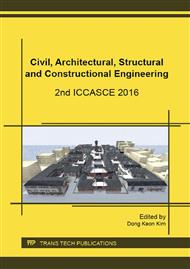p.179
p.184
p.190
p.196
p.202
p.208
p.214
p.219
p.227
Particleboard with Inclusion Bi-Oriented Polypropylene Applied in Architecture
Abstract:
This paper analyze the potentiality of using the BOPP (bi-oriented polypropylene), a byproduct of automotive battery labeling, in the bamboo particleboard production to be used in architecture projects. On this research, were studied both physical and mechanical properties according to the standards NBR 14810-3/2006 and ANSI A208.1/1999. The particleboards are produced in three traces: 75% bamboo and 25% BOPP, 50% bamboo and 50% BOPP and 100% bamboo. The adhesive used was polyurethane resin with a castor oil base, weighing 12% of the total mass of each panel. The physical properties of water absorption and thickness swelling, in both periods of 2 hours and 24 hours, demonstrated a direct relation with the amount of BOPP and impermeability of particleboards produced. Regarding the mechanical properties of bending and tensile strength, the addition of BOPP had an inverse relation to these properties.
Info:
Periodical:
Pages:
202-207
Citation:
Online since:
November 2016
Price:
Сopyright:
© 2017 Trans Tech Publications Ltd. All Rights Reserved
Share:
Citation:


